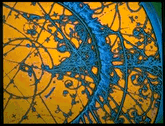|
Quark Shadows Stephen Andrew Taylor, 2001 |
 |
Premiered November 18, 2001, at the Chicago Symphony's MusicNOW series; other performances include April 2005 by the Composers Inc. Ensemble in San Francisco, conducted by David Milnes. Recorded in 2008 by Oto Carillo, horn; Masumi Rotad, viola; Michael Cameron, bass; and Daniel Schlosberg, piano; released in 2010 by Albany Records.
Program Note
"Quark Shadows" is my fanciful name for the trails left by quarks--among the smallest particles known to exist--in atom-smashing experiments. The darting, swirling lines in the first movement are a sort of aural realization of these trails. But shadows also suggest darkness and our ancient, supernatural beliefs. My quartet (horn, viola, doublebass and piano,which is "prepared" with rubber muting in its low register) tries to convey the wonder and excitement I feel at the intersection of bright, rational science and murky, instinctive human nature.
The second movement, "Symmetry Breaking," is inspired by another little scientific miracle, the birth of my daughter. The horn begins with a fanfare based on the natural overtone series, played into the resonating strings of the piano. The title, a beautiful phrase from modern physics, refers not to violence but the freeing of stasis: a crystal, perfectly symmetrical, can never be alive. Only when symmetry is broken can something new come into the world; scientists in fact use this concept to describe the first moments of the universe. Quark Shadows was commissioned by the Chicago Symphony; the first movement is dedicated to Augusta Read Thomas, the second to Hua Nian and Olivia Nian Taylor.
Performance Note
The piano has a strip of Blu-Tac running from the lowest A to the C# below middle C, muting the sound in the low register. The effect should sound like a "pizzicato" piano.
In the first movement most string harmonics are natural, including the flat 7th harmonic for the doublebass. For the doublebass, all pitches sound an octave lower than written, including treble clef and harmonics. The second movement uses a combination of natural and artificial harmonics, notated in the usual way.
The horn also sometimes plays on different natural harmonic series (written as "in G," --meaning 1st and 2nd fingering on the Bb horn--"in Db," etc.), producing the flat 7th and sharp 11th overtones. These are written as modified accidentals in the score, and should not be changed to sound "in tune."
Last updated March 9, 2010 by Stephen Andrew Taylor, [email protected]